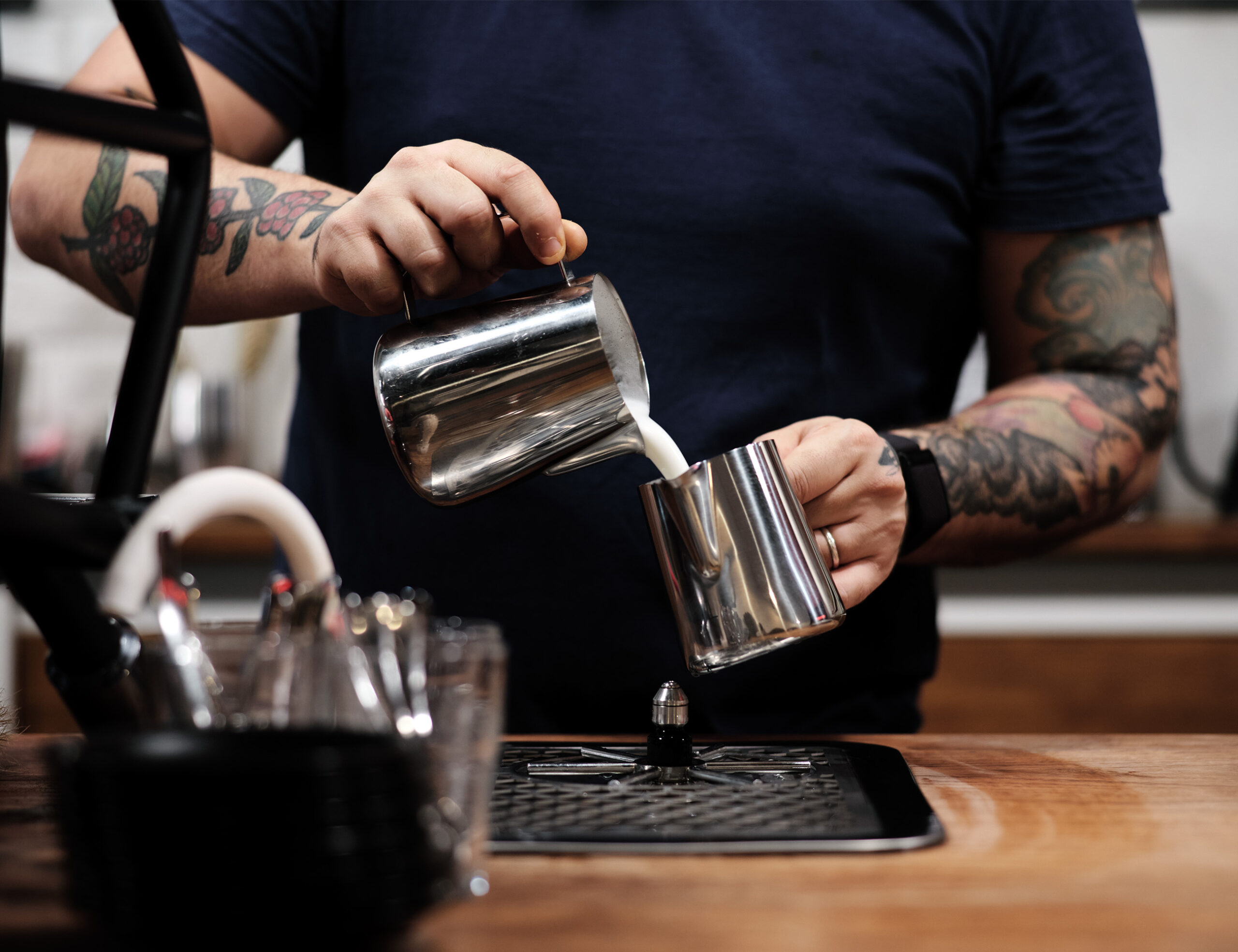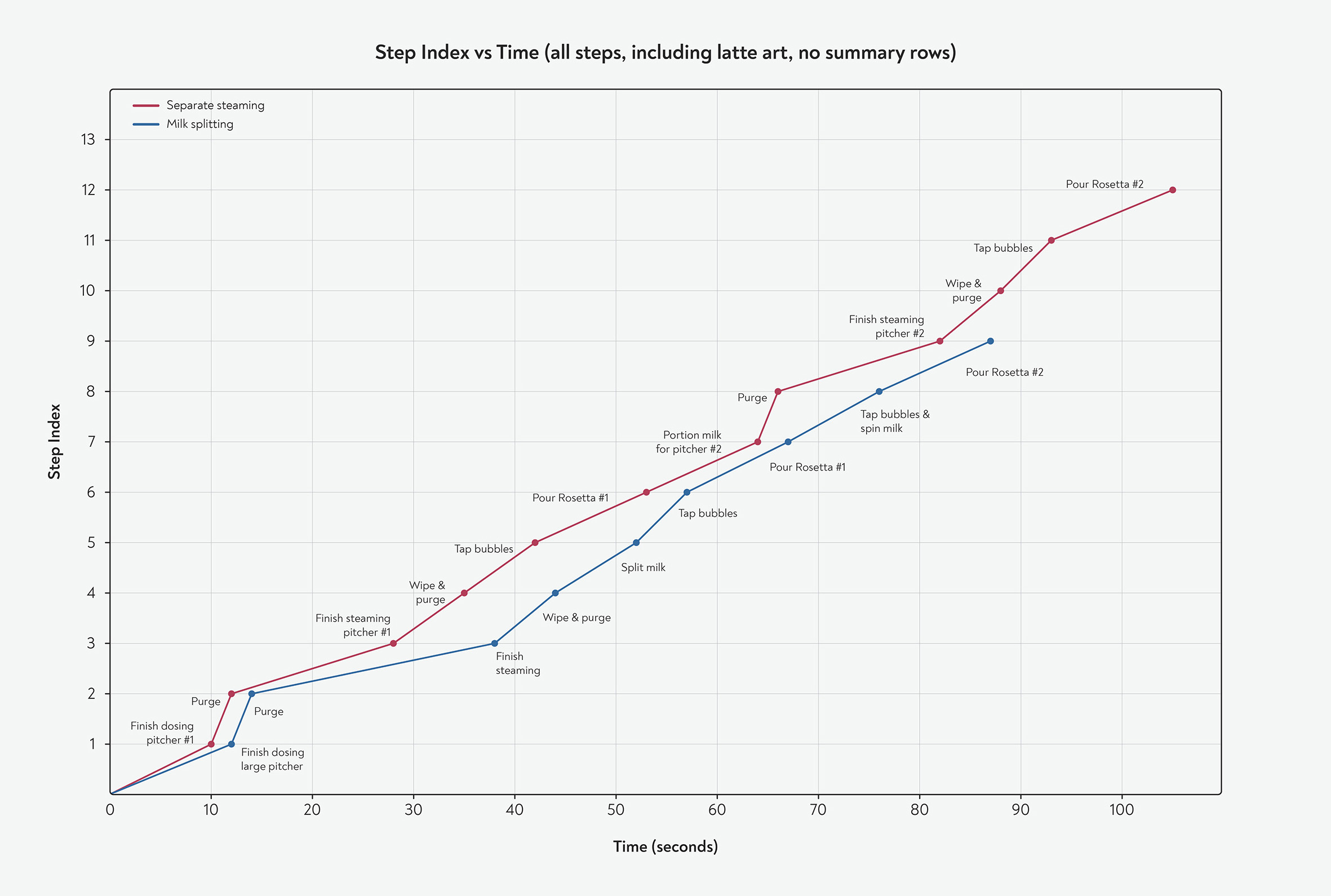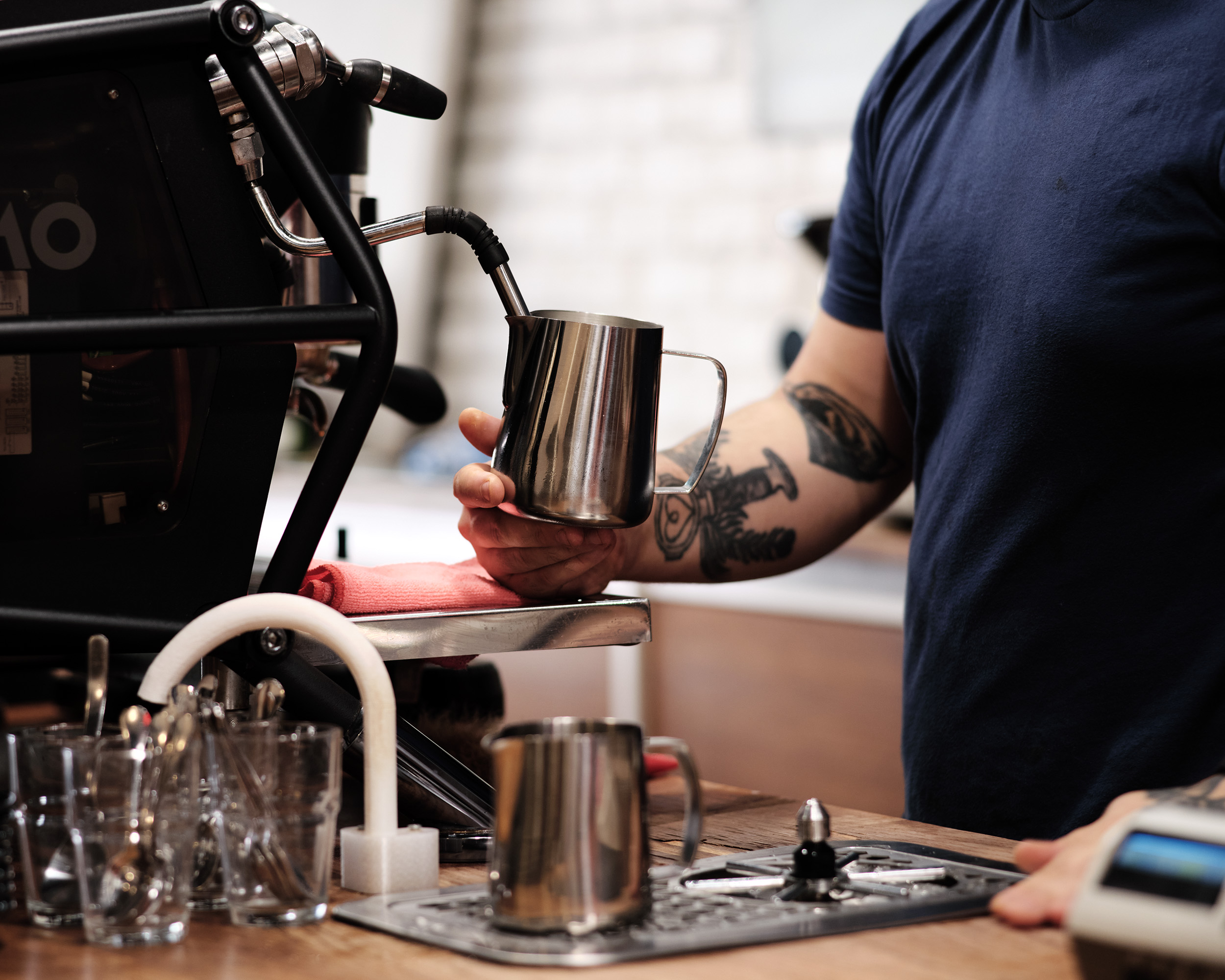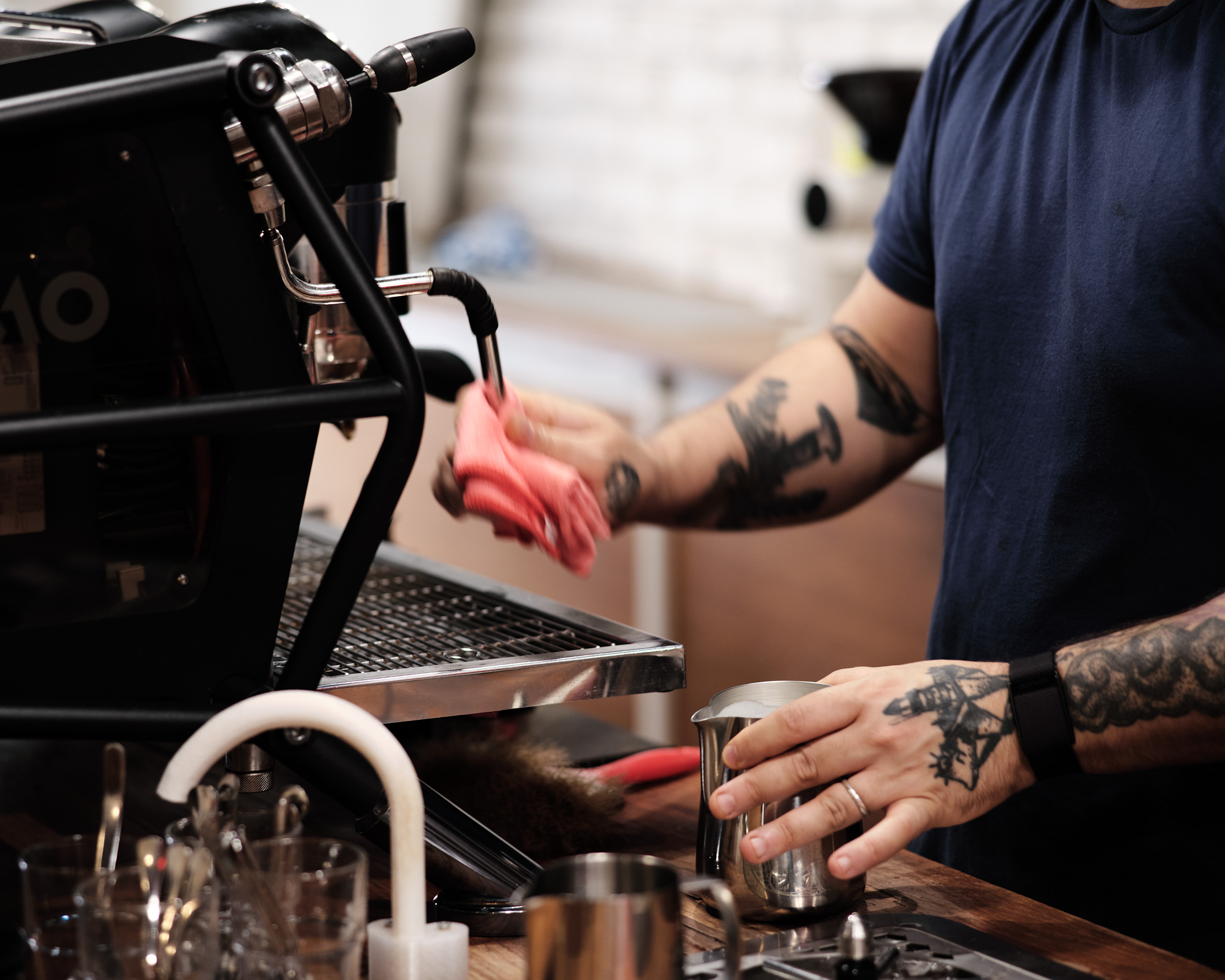There are two forms of barista … one which steams individually for each beverage, and one which steams in twos. One’s not higher than the opposite. Actually, Latte Artwork Champions are inclined to steam one after the other, and World Barista Champions are inclined to do two by twos. Should you steam 4 by 4, you’re not a barista in any respect… you’re a demigod. We don’t advocate that for abnormal mortals. At BH, we train you to do two by two. Allow us to clarify why it’s the best way ahead.
We simply printed a giant submit in regards to the significance of milk splitting. The purpose we had been making was that it’s the one option to assure you get equal foam on every beverage whenever you’re hustling on bar, making drinks two by two. Once we posted it up on Insta, one of many first feedback that got here by means of was from a barista who conjectured that it’s in all probability quicker to steam one after the other and skip the splitting altogether. Honest level — if you happen to go one-by-one, there’s no splitting required. However let me let you know now: Sooner it ain’t. And we will show it.
What’s Your Time Break up?
Our Dean of Research Jem Challender cracked open the Schultz milk (let’s give them a plug as a result of it’s marvellous non-homogenised natural milk from the southern state of Victoria, Australia) and set as much as conduct a time trial. First he ready two single-shot 6-oz espressos with milk the place he steamed individually for every beverage. Then he made one other pair of 6-oz drinks, the place he steamed in a single giant pitcher, then break up the milk in the best way we describe right here in our submit from final week.
 It takes time to purge, steam, wipe, purge, split…
It takes time to purge, steam, wipe, purge, split…
Let’s take a look at the time splits (no pun intended) to see what method was faster, what method creates less work for the barista, and where inefficiencies lie. Please note, for both sets Jem was hustling at top speed. He poured rosettas on each drink because it’s a simple quick 10-second design. Tulips take longer to pour because to pour them, you have to stop and start several times, so choose hearts or rosettas when you’re hustling. And he attempted to wipe and purge the steam wand as efficiently as possible. The timings we show here do not report on the preparation or extraction time for the espresso — we are just focussing on the milk. So the timer starts at the moment Jem first reaches for the milk bottle. Here are the results of the time trial:
| Time Trial Breakdown | |||||||
| Method 1: Steam Separately for Each Beverage | Method 2: Steam Together + Split | ||||||
| Step | Time | Duration | Step | Time | Duration | ||
| 0 | Start | 0:00 | — | 0 | Start | 0:00 | — |
| 1 | Finish dosing pitcher #1 | 0:10 | 10 sec | 1 | Finish dosing large pitcher | 0:12 | 12 sec |
| 2 | Purge | 0:12 | 2 sec | 2 | Purge | 0:14 | 2 sec |
| 3 | Finish steaming pitcher #1 | 0:26 | 16 sec | 3 | Finish steaming | 0:38 | 24 sec |
| 4 | Wipe & purge | 0:33 | 7 sec | 4 | Wipe & purge | 0:44 | 6 sec |
| 5 | Tap bubbles | 0:40 | 7 sec | 5 | Split milk | 0:52 | 8 sec |
| 6 | Pour Rosetta #1 | 0:51 | 11 sec | 6 | Tap bubbles | 0:57 | 5 sec |
| 7 | Portion milk for pitcher #2 | 1:02 | 11 sec | 7 | Pour Rosetta #1 | 1:07 | 10 sec |
| 8 | Purge | 1:04 | 2 sec | 8 | Tap bubbles (and spin milk) | 1:16 | 9 sec |
| 9 | Steam pitcher #2 | 1:20 | 16 sec | 9 | Pour Rosetta #2 | 1:26 | 11 sec |
| 10 | Wipe & purge | 1:26 | 6 sec | ||||
| 11 | Tap bubbles | 1:31 | 5 sec | ||||
| 12 | Pour Rosetta #2 | 1:43 | 12 sec | ||||
| Total Time | — | 1:43 | Total Time | — | 1:26 | ||
Observations
The milk splitting pair was 17 seconds faster. The ‘steam separately’ approach was 20% slower than the steam together. Can we agree that’s a pretty massive difference? And it’s not only the time factor you need to consider. Count up the actions involved in each method. With milk splitting, there’s half as many purges and wipes of the steam wand, and you only need to dose the milk once. This chart makes the difference pretty clear to see.
 The y shows a step index. That’s the amount of work involved. And the x axis shows the time in seconds. So it’s 13 steps for the steam separately and 9 for the milk splitting.
The y shows a step index. That’s the amount of work involved. And the x axis shows the time in seconds. So it’s 13 steps for the steam separately and 9 for the milk splitting.
Fewer repeat actions
Steaming once and purging once saves around 10 seconds on wand purging and wiping, 9 seconds on dosing the milk, and 8 seconds on steaming time. The comparison table (below) shows the delta between each type of work.
| Metric | Steam Separately | Milk Splitting | Δ |
| Number of Steam Cycles | 2 | 1 | 1 |
| Steaming (sec.) | 32 | 24 | 8 |
| Purge Cycles | 4 | 2 | 2 |
| Filling (sec.) | 21 | 12 | 9 |
A Note on Optimising the Separate-Steaming Method
If you’re still not convinced, it’s worth noting there is a way to improve the separate seaming stats by about 5-6 seconds: Separate-steaming method could be marginally improved by portioning milk into both pitchers at the outset, rather than stopping to portion the second one mid-workflow. This tweak would save a few seconds — by avoiding the need to remove and replace the milk bottle lid twice.
Still, it’s not a full time saving. You’d still be steaming twice, wiping twice, and pouring twice. So while batching the milk dosing makes sense, it doesn’t close the gap on the clear time advantage of the steam-and-split method.
Want to Go Even Faster?
You heard a way to speed up the steam separately, but you can buy yourself another 6-7 seconds of speed with milk-splitting too. You’ll notice in the video, just before the final pour of the milk-splitting round, Jem pours the contents of the large pitcher back into the smaller pitcher. This is done to counteract drainage and it helps to improve your latte art. But it’s not an essential step. Just a quick spin of the pitcher should be enough to reintegrate the layers. You simply pour the second beverage from the large pitcher, instead of transferring it to the small pitcher. It takes a bit more practice to pour a good design from a larger pitcher, but if you have the need for speed, that efficiency alone makes milk splitting 28% quicker than steaming separately.
![Time Trial — I Gotta [Time] Break up](https://grindedbeancafe.com/wp-content/uploads/2025/08/I-Gotta-Split-II-PostHeader-scaled-750x382.jpg)



